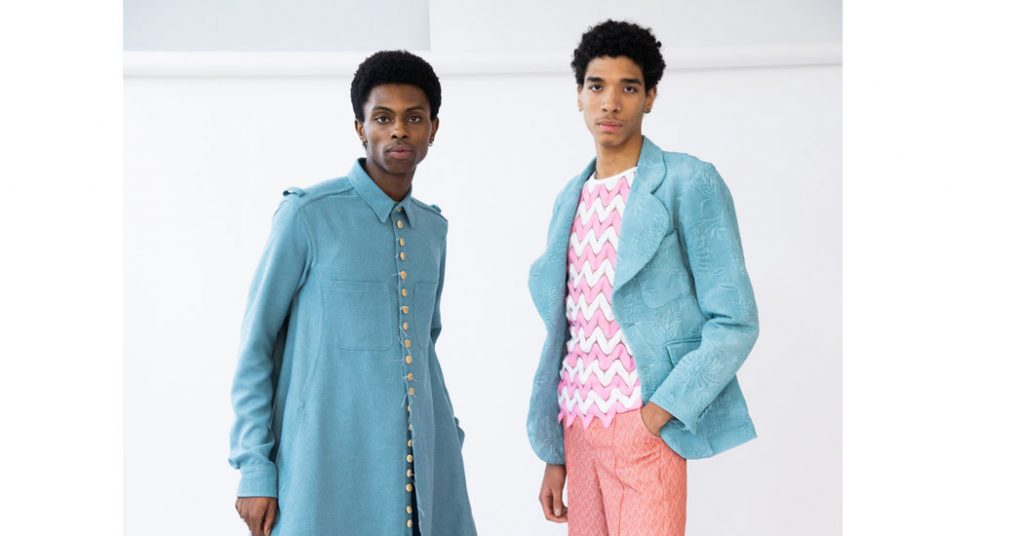The idea for KEH was born in 2017 when friends Wei Ge and Aoyu Zhang were waiting in line at the opening of the Dover Street Market boutique in Singapore. The long queue gave the duo, both designers, a chance to discuss the next steps in their respective careers — and their shared ambition to start their own label. They’d met five years before at the Academy of Arts and Design, Tsinghua University in Beijing. Ge went on to become an assistant designer at the popular Chinese label Zuczug while Zhang earned a master’s degree in business from Nanyang Technological University in Singapore. After two years of development, the pair launched their own brand — choosing the name KEH simply for its pleasing sound — in New York in March 2019. From the beginning, they wanted to create gender-fluid clothing that represented what they and their friends wanted to wear. As Ge says, “KEH deconstructs and mixes elements from both men’s wear and women’s wear.” The brand’s fall 2020 collection, which the designers showed in New York this season, was inspired by the photographer Nick Knight’s surreal images of roses and includes tailored garments made from environmentally friendly cotton as well as a cape constructed from pieces of mottled gray wool arranged to resemble the petals of a flower.
Claire McKinney and Sophie Andes-Gascon both moved to New York in 2011 to study fashion design at the Pratt Institute in Brooklyn. McKinney grew up in Portland, Oregon, where, as a child, she would make costumes using pillowcases and blankets borrowed from the family’s linen closet. Andes-Gascon was born in Manaus, Brazil, but later moved to Maryland, where her father taught her how to sew and knit. For a time, the two classmates shared an apartment, and in 2015 they both landed jobs as design consultants for the brand Maryam Nassir Zadeh, where they still work. They each continued to create their own clothes on the side and eventually formed a partnership; in 2019, they launched SC103, which specializes in custom dyes and handcrafted elements, with a runway show in downtown Manhattan that was, in a departure from the traditional fashion presentation format, open to the public. “We reject the idea of exclusivity and embrace an open and democratic policy,” says McKinney. “We want to share this experience with people outside the fashion world.” The name SC103 is a nod to the pair’s personal bond: It’s derived from the first letters of their names, combined with the building number of their first shared apartment and studio. For fall 2020, the designers will show brightly colored hand-knits paired with workwear-inspired trousers, armor-like garments made from linked leather panels, and shrunken sweaters and pants designed to mimic ones that have been washed on too high a heat.
Since meeting at Central Saint Martins, Amy Trinh and Evan Phillips have built impressive resumes: Trinh interned at Louis Vuitton, Craig Green, and Stella McCartney; Phillips assisted Richard Quinn with his first collections before working on development at Simone Rocha. Both of their careers shifted course, though, when Trinh got engaged in 2018 and discovered that the type of unconventional wedding dress she wanted didn’t exist. “I realized there was something missing,” she says, “namely, dresses that could be worn more than once.” She reached out to Phillips to help her create a dress, and that conversation became the starting point for their bridal-inspired ready-to-wear label WED, which debuted last year. The pair’s goal is to create garments that can be worn both on and long after a person’s wedding day. “It’s about making bridal wear more sustainable and changing the mentality that a wedding dress should be boxed up and never worn again,” Phillips says. The pair also want to reimagine what wedding attire means in a world where the concept of marriage is changing and becoming more inclusive. Their new collection, which will be their second to date, will be shown by appointment in Paris. “The garment drapes are based on a swirling movement,” explains Phillips of the pieces, which include an A-line taffeta skirt with a dramatic spiral-like silhouette. This season, the designers have also collaborated with the 300-year-old English mill Stephen Walters, and have repurposed many of the company’s dead-stock fabrics, from a quilted jacquard to a striped satin.
This content was originally published here.
